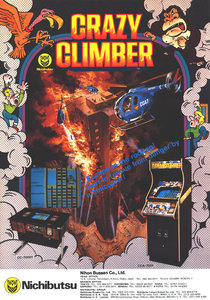
Crazy Climber is a vertically scrolling video game produced by Nichibutsu and released for arcades in 1980. In North America, the game was also released by Taito America. Ports for the Arcadia 2001 and Atari 2600 were published in 1982, followed by the Famicom in 1986 and X68000 in 1993.

Track & Field, also known as Hyper Olympic in Japan and Europe, is an Olympic-themed sports video game developed by Konami and released as an arcade video game in 1983. The Japanese release sported an official license for the 1984 Summer Olympics. In Europe, the game was initially released under the Japanese title Hyper Olympic in 1983, before re-releasing under the US title Track & Field in early 1984.

Ikari Warriors, known as Ikari in Japan, is a vertically scrolling run and gun video game released for arcades by SNK in 1986. It was published in North America by Tradewest. At the time there were many Commando clones on the market. What distinguished Ikari Warriors were rotary joysticks and a two-player cooperative mode. The rotary joystick controls were in turn based on SNK's earlier TNK III (1985). Ikari was originally intended to be an official licensed adaptation of the film Rambo: First Blood Part II (1985), but SNK were initially unable to acquire the rights to the film.

Commando, released as Senjō no Ōkami in Japan, is a vertically scrolling run and gun video game released by Capcom for arcades in 1985. The game was designed by Tokuro Fujiwara. It was distributed in North America by Data East, and in Europe by several companies including Capcom, Deith Leisure and Sega, S.A. SONIC. Versions were released for various home computers and video game consoles. It is unrelated to the 1985 film of the same name, which was released six months after the game.
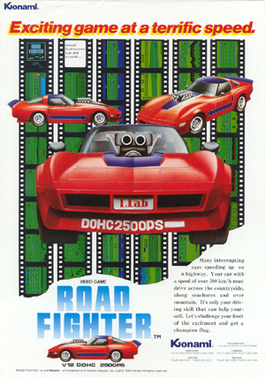
Road Fighter is a racing arcade video game developed by Konami and released in 1984, and was the first racing game from the company. The goal is to reach the finish line within the stages without running out of time, hitting other cars or running out of fuel. The game spawned a spiritual successor, Konami GT (1986), and two sequels, Midnight Run: Road Fighter 2 (1995) and Winding Heat (1996). A Japan-only sequel was also released 14 years later, Road Fighters (2010).
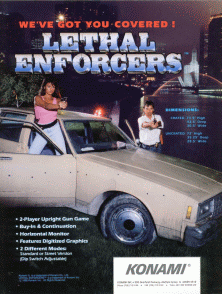
Lethal Enforcers is a 1992 light gun shooter released as an arcade video game by Konami. The graphics consist entirely of digitized photographs and digitized sprites. Home versions were released for the Super NES, Genesis and Sega CD during the following year and include a revolver-shaped light gun known as The Justifier.

Gun.Smoke is a vertically scrolling run and gun video game and designed by Yoshiki Okamoto and released in arcades in 1985. Gun.Smoke centers on a character named Billie Bob, a bounty hunter going after the criminals of the Wild West.

WWF WrestleFest is a professional wrestling video game developed and released by Technōs Japan for arcades in 1991, featuring stars of the World Wrestling Federation (WWF). The game was distributed by Technōs in Japan and North America, and by Tecmo in Japan, Europe and Australasia. It is the sequel to Technōs' previous WWF game, WWF Superstars. Compared to Superstars, WrestleFest adds a variety of different wrestlers to the roster as well as enhanced graphics and sound. There are more voice samples, including commentary and pre-match introductions by WWF ring announcer Mike McGuirk. The voiced cut scenes featuring Gene Okerlund from Superstars returned as well.
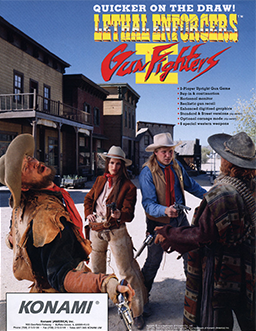
Lethal Enforcers II: Gun Fighters, known in Japan as Lethal Enforcers 2: The Western, is a 1994 light gun shooter arcade game and a prequel to the original Lethal Enforcers. In contrast with the first game's modern law enforcement theme, Lethal Enforcers II takes place in the American Old West.

Hyper Sports, known in Japan as Hyper Olympic '84, is an Olympic-themed sports video game released by Konami for arcades in 1984. It is the sequel to 1983's Track & Field and features seven new Olympic events. Like its predecessor, Hyper Sports has two run buttons and one action button per player. The Japanese release of the game sported an official license for the 1984 Summer Olympics.

International Track & Field, known in Japan as Hyper Olympic in Atlanta, is a 3D update of Konami's Track & Field series, in which up to four players compete in eleven different Olympic events. The game was released for the PlayStation and arcades in 1996. The arcade version was released only in Japan as Hyper Athlete. A Game Boy Color game was released in 1999. It was known in Japan as Hyper Olympic Track & Field GB and International Track & Field in Europe and North America. In 2008 the game was released on PlayStation Network as a PS one Classic. All six events from the first game, 1983's Track & Field, are included, but only three events are taken from the sequel, Hyper Sports. International Track & Field uses the three-button control system of its predecessors and the eleven disciplines can be attempted in any order.

Street Fighter II Turbo: Hyper Fighting is a competitive fighting game released by Capcom for arcades in 1992. It is the third arcade version of Street Fighter II, part of the Street Fighter franchise, following Street Fighter II: Champion Edition, and was initially released as an enhancement kit for that game. Released less than a year after the previous installment, Turbo introduced a faster playing speed and new special moves for certain characters, as well as further refinement to the character balance.

Konami GT, originally known as Konami RF2 - Red Fighter, is a 1985 racing video game developed and released by Konami, using their GX400 arcade architecture. The player drives a sports car which must reach various checkpoints without running out of fuel. A turbo mode increases the car's speed but uses more fuel and puts the player at a higher risk of hitting an obstacle. Fuel power-ups can be found on the road which the player must pick up to make it to the final checkpoint.
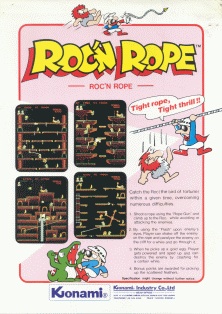
Roc'n Rope is a platform game released in arcades in 1983 by Konami, Kosuka, and Interlogic. It was designed by Tokuro Fujiwara. The player controls a flashlight and harpoon-gun equipped archaeologist who must ascend a series of rocky platforms to reach a phoenix bird.

Aliens is a 1990 run and gun video game developed and published for arcades by Konami. It is based on the 1986 film of the same title. Two players can play the game cooperatively in addition to single-player.

Cyber Sled is a vehicular combat video game developed and published by Namco. It was originally released for arcades in 1993. The game's perspective is third-person by default, but can be switched to a first-person perspective. The game was nominated for Most Innovative New Technology at the 1994 AMOA Awards. It later received a sequel in 1994, Cyber Commando.

Super Contra, known as Super Contra: The Alien Strikes Back in Japan, is a run and gun video game by Konami, originally released as a coin-operated arcade video game in January 1988. It is the sequel to the original Contra and part of the Contra series. The game stars Bill Rizer and Lance Bean as they are sent to thwart another alien invasion from the vicious Red Falcon.

GTI Club: Rally Côte d'Azur is a racing video game developed and published by Konami for the arcades in 1996. It is the first game in the GTI Club series. It was re-released for PlayStation Network in 2008.


















